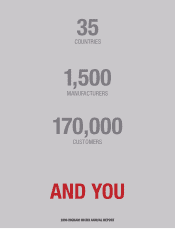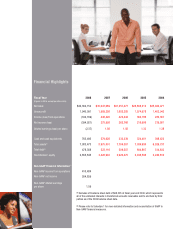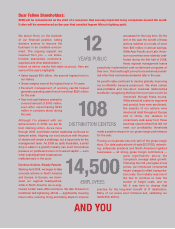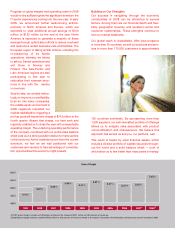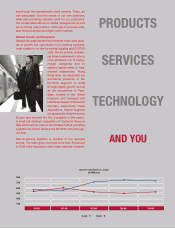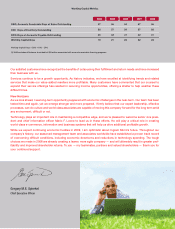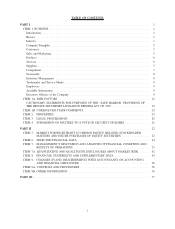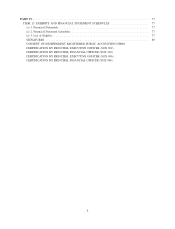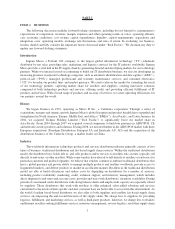Ingram Micro 2008 Annual Report Download - page 11
Download and view the complete annual report
Please find page 11 of the 2008 Ingram Micro annual report below. You can navigate through the pages in the report by either clicking on the pages listed below, or by using the keyword search tool below to find specific information within the annual report.
PART I
ITEM 1. BUSINESS
The following discussion includes forward-looking statements, including but not limited to, management’s
expectations of competition; revenues, margin, expenses and other operating results or ratios; operating efficien-
cies; economic conditions; cost savings; capital expenditures; liquidity; capital requirements; acquisitions and
integration costs; operating models; exchange rate fluctuations and rates of return. In evaluating our business,
readers should carefully consider the important factors discussed under “Risk Factors.” We disclaim any duty to
update any forward-looking statements.
Introduction
Ingram Micro, a Fortune 100 company, is the largest global information technology (“IT”) wholesale
distributor by net sales, providing sales, marketing, and logistics services for the IT industry worldwide. Ingram
Micro provides a vital link in the IT supply chain by generating demand and developing markets for our technology
partners. While we remain focused on continuing to build our IT distribution business, we also are developing an
increasing presence in adjacent technology categories, such as automatic identification and data capture (“AIDC”);
point-of-sale (“POS”); managed, professional and warranty maintenance services; and consumer electronics
(“CE”) to broaden our product lines and market presence. We create value in the market by extending the reach
of our technology partners, capturing market share for resellers and suppliers, creating innovative solutions
comprised of both technology products and services, offering credit, and providing efficient fulfillment of IT
products and services. With a broad range of products and an array of services, we create operating efficiencies for
our partners around the world.
History
We began business in 1979, operating as Micro D Inc., a California corporation. Through a series of
acquisitions, mergers and organic growth, Ingram Micro’s global footprint and product breadth have expanded and
strengthened in North America; Europe, Middle East and Africa (“EMEA”); Asia-Pacific; and Latin America. In
2004, we acquired Techpac Holding Limited (“Tech Pacific”) to significantly boost our market share in
Asia-Pacific. From 2004 through 2007 we acquired several companies to build our presence in AIDC/POS, CE
and network security products and solutions. During 2008, we invested further in the AIDC/POS market with three
European acquisitions (Paradigm Distribution, Eurequat SA and Intertrade A.F. AG) and the acquisition of the
distribution business of the Cantechs Group, a market leader in China.
Industry
The worldwide information technology products and services distribution industry generally consists of two
types of business: traditional distribution and fee-based supply chain services. Within the traditional distribution
model, the distributor buys, holds title to, and sells products and/or services to resellers who, in turn, typically sell
directly to end-users, or other resellers. While some vendors have elected to sell directly to resellers or end-users for
particular customer and product segments, we believe that vendors continue to embrace traditional distributors that
have a global presence and proven ability to manage multiple products and resellers worldwide, provide access to
fragmented markets, and deliver products to market in an efficient manner. Resellers in the traditional distribution
model are able to build efficiencies and reduce costs by depending on distributors for a number of services,
including product availability, marketing, credit, technical support, and inventory management, which includes
direct shipment to end-users and, in some cases, provides end-users with distributors’ inventory availability. During
periods of constrained credit, distributors with strong balance sheets and ample credit capacity are especially valued
by suppliers. Those distributors that work with resellers to offer enhanced value-added solutions and services
customized to the needs of their specific end-user customer base are better able to succeed in this environment. As
the world’s leading broad-based distributor, we also offer to both suppliers and resellers fee-based supply chain
services, encompassing the end-to-end functions of the supply chain. We charge fees to suppliers for providing
logistics, fulfillment, and marketing services, as well as third-party products. Likewise, we charge fees to retailers
and Internet resellers seeking fulfillment services, inventory management, reverse logistics, and other supply chain
1

